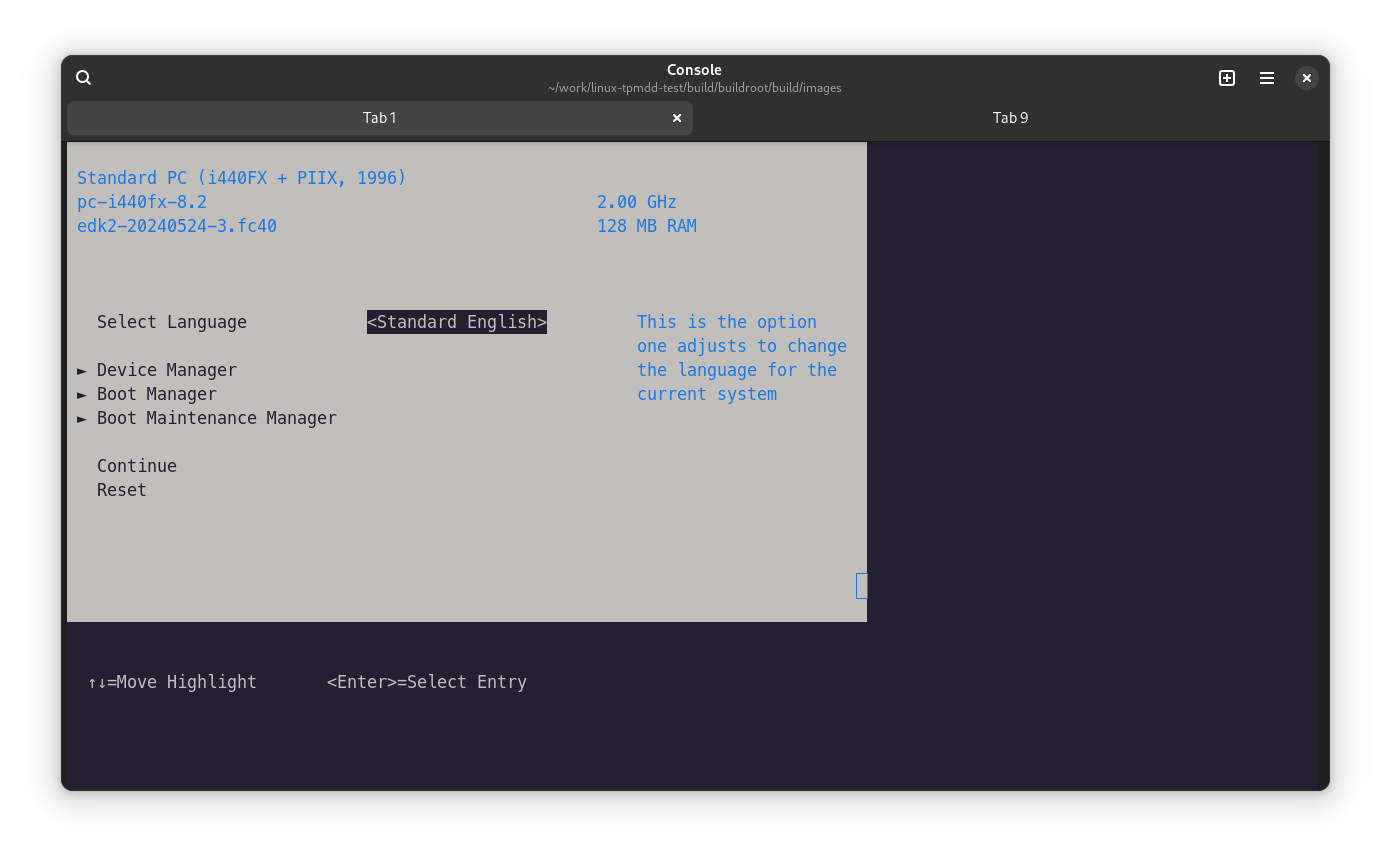Posts
5046Following
330Followers
504OpenPGP: 3AB05486C7752FE1
Jarkko Sakkinen
jarkko- gpg-agent-browser.socket
- gpg-agent-extra.socket
I keep them disabled because I need only gpg-agent.socket and gpg-agent-ssh.socket but for completeness sake would be nice to know what they are.
Jarkko Sakkinen
jarkkoWhat do in my custom #BuildRoot and #systemd based image to this error:
[FAILED] Failed to mount EFI System Partition Automount.
See 'systemctl status efi.mount' for details.
[ OK ] Finished Update Boot Loader Random Seed.
tpm_tis MSFT0101:00: 2.0 TPM (device-id 0x1, rev-id 1)
random: crng init done
[ OK ] Started Network Name Resolution.
[ OK ] Reached target Host and Network Name Lookups.
Mounting EFI System Partition Automount...
Starting Virtual Console Setup...
[FAILED] Failed to mount EFI System Partition Automount.
See 'systemctl status efi.mount' for details.
[FAILED] Failed to start Automatic Boot Loader Update.
See 'systemctl status systemd-boot-update.service' for details.
I have no idea what those error messages mean.
The source is here: https://gitlab.com/jarkkojs/linux-tpmdd-test
And here’s the output for the “details”:
# systemctl status systemd-boot-update.service
× systemd-boot-update.service - Automatic Boot Loader Update
Loaded: loaded (/usr/lib/systemd/system/systemd-boot-update.service; enabled; preset: enabled)
Active: failed (Result: exit-code) since Wed 2024-06-12 01:50:17 UTC; 2h 58min left
Docs: man:bootctl(1)
Process: 87 ExecStart=bootctl --no-variables --graceful update (code=exited, status=1/FAILURE)
Main PID: 87 (code=exited, status=1/FAILURE)
CPU: 28ms
Jun 12 01:50:15 tpmdd systemd[1]: Starting Automatic Boot Loader Update...
Jun 12 01:50:17 tpmdd bootctl[87]: Failed to open parent directory of "/efi": No such device
Jun 12 01:50:17 tpmdd systemd[1]: systemd-boot-update.service: Main process exited, code=exited, status=1/FAILURE
Jun 12 01:50:17 tpmdd systemd[1]: systemd-boot-update.service: Failed with result 'exit-code'.
Jun 12 01:50:17 tpmdd systemd[1]: Failed to start Automatic Boot Loader Update.
Jarkko Sakkinen
jarkkoEven tho this image built only for #kernel test and could in theory run just bzImage as #ELF-executable, systemd-boot makes sense given the ability to modify the kernel command-line without compiling the kernel.
So I can now conclude that I've migrated from #busybox to systemd in my kernel testing workflow :-)
#linux
Jarkko Sakkinen
jarkkoUsing any formation of #Signal App, is it possible to get #SGX #attestation of contact discovery back to the client and view the certificate, or how does it benefit the end user?
Or is from client possible to get this attestation using the raw protocol that the app uses?
Jarkko Sakkinen
jarkkoActually not yet too successful booting my #BuildRoot image with systemd-boot. With grub-efi I got to the login.
EDIT: I think I got it and it is pretty obvious. I’m still deploying GRUB style configs when I construct the disk image with genimage, so I just fix them up as systemd boot style configs (found a reference for that).
So I just follow along [1] and cross my fingers ;-) I think it is good exercise to build from scratch a systemd image from boot to user space in all cases.
[1] https://www.freedesktop.org/wiki/Software/systemd/systemd-boot/
Jarkko Sakkinen
jarkkoThe summary of #systemd #spam of today:
- I got it fully working for my #BuildRoot image build.
- It boots with no errors.
- Compilation time is still not much different than with #Busybox.
- Uses now systemd-boot instead of GRUB (thanks @vathpela for comments).
- Uses systemd version 254. Plan is to get into phase.
- For BuildRoot, uses the master branch of: https://gitlab.com/jarkkojs/linux-tpmdd-test
I “systemd” re-initiated the history of my test repository: https://gitlab.com/jarkkojs/linux-tpmdd-test. From now on I commit on keeping a proper versions on this :-) It had no forks so far so I’m the only person who had consequences on that action.
Jarkko Sakkinen
jarkkoMy #systemd feature awareness is always about two years old because you don’t become aware of its features by doing #kernel development :-)
For instance, I had no idea that systemd already natively supported #TPM2 before month or two ago someone told me about systemd-cryptenroll. I had seen the utility tho in some article but had a blind spot for the prefix.
Now that I’ve seen systemd’s TPM2 implementation in source level I can only say that it is somewhat bloated but I guess it is working fine :-) It is bloated because it would have been better idea just directly use the device. So not a great implementation, but at least a working one. That said, it is not a major glitch but IMHO could be rewritten at some point, with the motivation of decreasing dependencies and compilation times.
In order to address the 1-2 year turn-over issue, I’ll try to get my #BuildRoot build to generate a fully working #systemd environment.
Jarkko Sakkinen
jarkkoHowever, it boots into emergency mode. Any tips or ideas?
My end product is 2GB img file that can be booted either with real hardware or in QEMU (it has #UEFI layout).
Jarkko Sakkinen
jarkkoMy lessons learned from #ethprague was these are the key algorithms:
- P256-K1 also known as the #bitcoin curve.
- Keccak-256, as it was before it became SHA-3. AFAIK, they have just some padding incompatibility. This is the hash used in #ethereum.
I don’t see really any problem make them a bit more “stack compatible”. So maybe something to look at after I get my TPM2 public key patch set into the mainline.
So like when running bunch of servers, how to seal your keys properly, pretty basic stuff.
Jarkko Sakkinen
jarkkoI mean... it is simple really. The current ones just turn ******g off. But, if just by pure accident the tables were turned. That is undefined society model that probably does not have even a name yet
I'm always looking for an adventure, but not the AI slavery dystopian one... Be forewarned, I mean this have at least theoretical chances of actually realizing in a form or another. More like due than potential risk IMHO.
Jarkko Sakkinen
jarkkoJarkko Sakkinen
jarkko#teardown and #bootstrap gpg-agent, pcscd to have a working configuration:
#!/usr/bin/env sh
# Copyright (c) Jarkko Sakkinen 2024
# Bootstrap gpg-agent and pcscd for Yubikey use.
GPG_AGENT_SOCKETS=(gpg-agent-ssh.socket
gpg-agent-browser.socket
gpg-agent-extra.socket
gpg-agent-ssh.socket
gpg-agent.socket)
systemctl --user disable --now "${GPG_AGENT_SOCKETS[@]}"
gpgconf --kill gpg-agent
sudo systemctl disable --now pcscd.socket
systemctl --user enable --now gpg-agent.socket gpg-agent-ssh.socket
sudo systemctl enable --now pcscd.socket
Jarkko Sakkinen
jarkkoWhy Curve25519 uses EdDSA for signing, and SECP-P256-R1 and SECP-P256-K1 use ECDSA?
It’s the scale. Curve25519 field has the size that fits within 255 bits, and two previous have the size that fits within 256 bits.
So from that follows:
- a new signature formalization is needed to reach similar or better results.
- given the smaller size it can only reach this goal by integrating tightly to the choices of the finite field parameters.
There is formal backing for this but pure common sense it is exactly like “if loose some, you must gain some” ;-)
Jarkko Sakkinen
jarkkoI realized that I have something profound broken in my asymmetric TPM2 key series: TPM2 specific keys should only sign, not verify.
struct public_key, which is the central structure used for built-in, vendor and machine owner keys, should be able to verify the signature, even when the TPM chip is removed.
As a consequence, I will delete all the verification code from the key type(s) and set the supported_ops a KEYCTL_SUPPORTS_SIGN, instead of previous KEYCTL_SUPPORTS_SIGN | KEYCTL_SUPPORTS_VERIFY.
I’ll also rework tests to have two asymmetric keys: one for signing in the chip and other outside holding only the public key. That should also better verify that the feature is working correctly.
Jarkko Sakkinen
jarkkoIn my opinion, a working design for kernel developers for this would be an image that would have the some recent release number, and easy way to build and deploy a test kernel.
Jarkko Sakkinen
jarkkoRight. I should take my TPM2 signing code and merge it to struct public_key, use only TPM2_Sign and ditch TPM2_RSA_Decrypt.
Just hit me out of the void. Then e.g. builtin/secondary/machine keyrings, x.509 certiificates etc. is also in the finish line once this feature lands :-)
Three week clocked to the development so far so I think this is going in good phase.
I’ll start a new series (because it is not the exact same feature as before).

